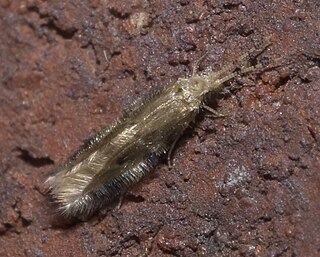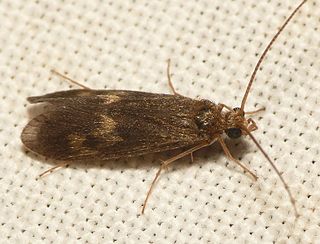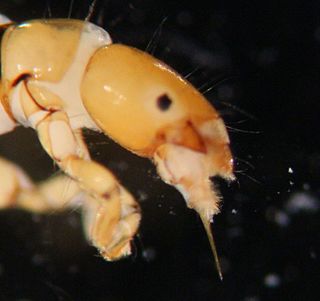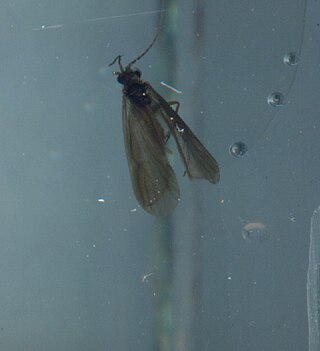
The caddisflies, or order Trichoptera, are a group of insects with aquatic larvae and terrestrial adults. There are approximately 14,500 described species, most of which can be divided into the suborders Integripalpia and Annulipalpia on the basis of the adult mouthparts. Integripalpian larvae construct a portable casing to protect themselves as they move around looking for food, while annulipalpian larvae make themselves a fixed retreat in which they remain, waiting for food to come to them. The affinities of the small third suborder Spicipalpia are unclear, and molecular analysis suggests it may not be monophyletic. Also called sedge-flies or rail-flies, the adults are small moth-like insects with two pairs of hairy membranous wings. They are closely related to the Lepidoptera which have scales on their wings; the two orders together form the superorder Amphiesmenoptera.

The Hydroptilidae are a large family of caddisflies (Trichoptera) with a worldwide distribution. They are commonly known as microcaddisflies or purse-case caddisflies, in reference to two characteristic traits of this family: Hydroptilidae are much smaller than other caddisflies, rarely exceeding 5 mm (0.20 in) in length. Their larvae do not build a protective case until the final instar of their growth. At that time however, they build a typically Purse-shaped case, either portable or stuck to the substrate, in which the larva finishes growth and pupates.

The Hydropsychidae are a family-level taxon consisting of net-spinning caddisflies. Hydropsychids are common among much of the world's streams, and a few species occupy the shorelines of freshwater lakes. Larvae of the hydropsychids construct nets at the open ends of their dwellings which are responsible for their "net-spinning caddisfly" common name.

The Ecnomidae are a family of caddisflies comprising 9 genera with a total of 375 species.

The Polycentropodidae are a family of trumpet-net and tube-making caddisflies. There are at least 30 genera and 720 described species in Polycentropodidae. The type genus for Polycentropodidae is Polycentropus J. Curtis, 1835.

The Psychomyiidae are a family of tube-making caddisflies. Members of this family are typically very similar to polycentropodids, most of them can be differentiated by the spur formula is 2-4-4, thyridial cell short, absence of the forewing fork I, and hindwing forks I and IV. Male genitalia has elongate preanal appendages, and reduced tergum IX. The larvae differ by the submental sclerites separated, foretrochantin broad, and the pupal mandible apex whip-like. Larvae construct long silken galleries.

Dipseudopsidae is a family of caddisflies in the order Trichoptera. There are about 6 genera and at least 110 described species in Dipseudopsidae.
The Glossosomatidae are a family of the class Insecta and order Trichoptera.The family contains 23 genera in three subfamilies. In the US alone, there are 76 spp. in 6 different genera.

Ephemerellidae are known as the spiny crawler mayflies. They are a family of the order Ephemeroptera. There are eight genera consisting of a total 90 species. They are distributed throughout North America as well as the UK. Their habitat is lotic-erosional, they are found in all sizes of flowing streams on different types of substrates where there is reduced flow. They are even found on the shores of lakes and beaches where there is wave action present. They move by swimming and clinging, they are very well camouflaged. Most species have one generation per year. They are mostly collector-gatherers.

Bloody Run is a tributary of West Branch Fishing Creek in Sullivan County, Pennsylvania, in the United States. It is approximately 2.9 miles (4.7 km) long and flows through Davidson Township. The watershed of the stream has an area of 1.30 square miles (3.4 km2). Various glacial tills and bedrock consisting of sandstone and shale are found in the vicinity of the stream. The stream is designated for use by aquatic life and is a High-Quality Coldwater Fishery.
Kokiriidae is a family of insect in the order Trichoptera. It was discovered in 1964 and is found in Australia, Chile, New Caledonia, and New Zealand. It consists of fifteen species and six genera.

Brachycentridae is a family of humpless casemaker caddisflies in the order Trichoptera. It is found in North America, Europe, and Asia. Georg Ulmer first described it in Germany in 1903 as a subfamily of Sericostomatidae. The type genus for Brachycentridae is Brachycentrus J. Curtis, 1834.
Georg Ulmer was a German entomologist who specialized in research of Trichoptera (caddisflies) and Ephemeroptera (mayflies).
Dolophilodes distinctus is a species of caddisfly in the Philopotamidae family. The larvae are found in streams in eastern North America where they build net-like retreats.

Uenoidae is a family of stonecase caddisflies in the order Trichoptera. There are about 7 genera and at least 80 described species in Uenoidae.

Neophylax is a genus of autumn mottled sedges in the family Uenoidae. There are more than 30 described species in Neophylax.

Lype is a genus of net tube caddisflies in the family Psychomyiidae. There are more than 20 described species in Lype.

Molanna is a genus of hood casemakers in the family Molannidae. There are more than 20 described species in Molanna.

Phylocentropus is a genus of caddisflies in the family Dipseudopsidae. There are about 17 described species in Phylocentropus.

Holocentropus is a genus of tube maker caddisflies in the family Polycentropodidae. There are more than 40 described species in Holocentropus.














